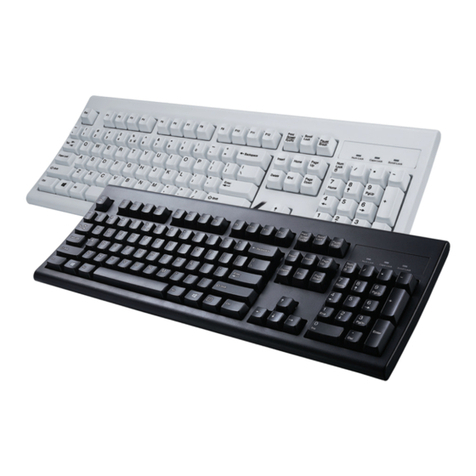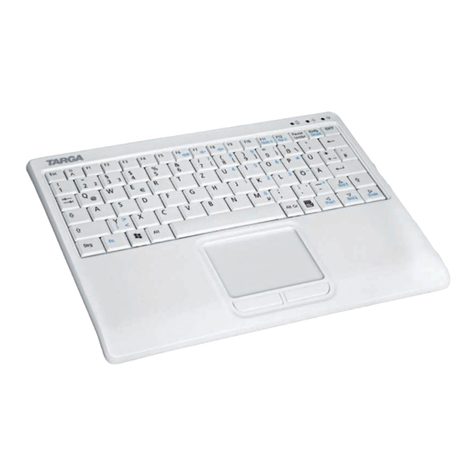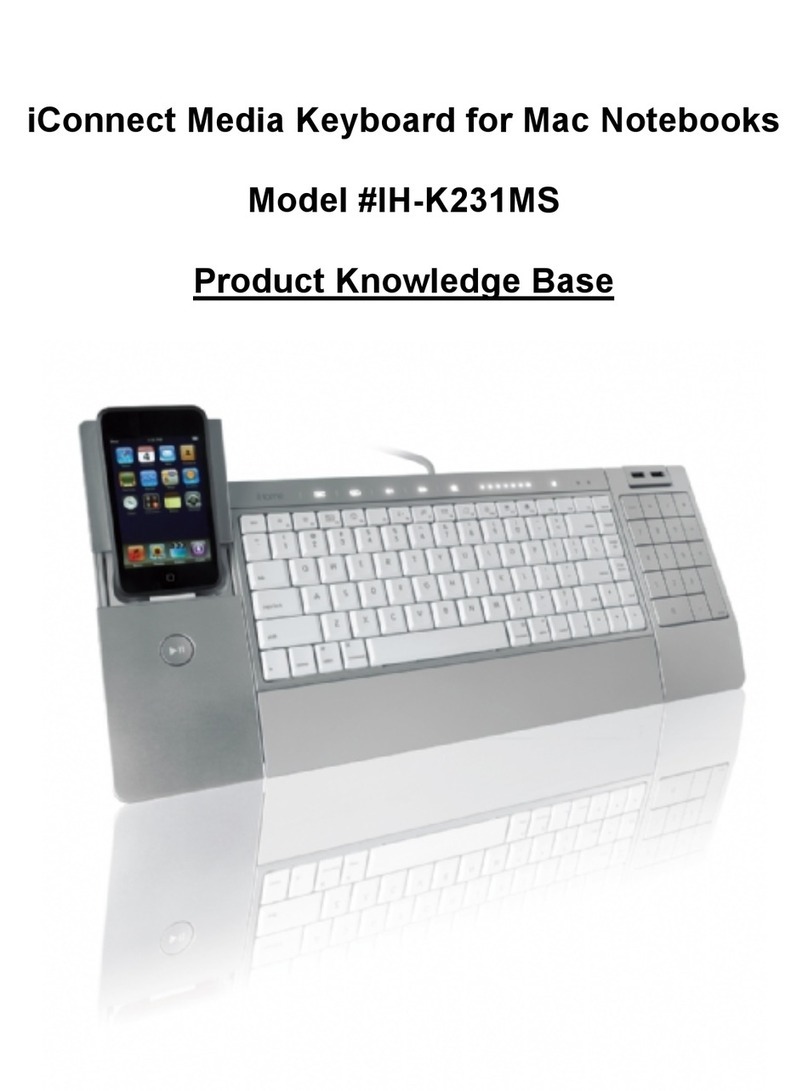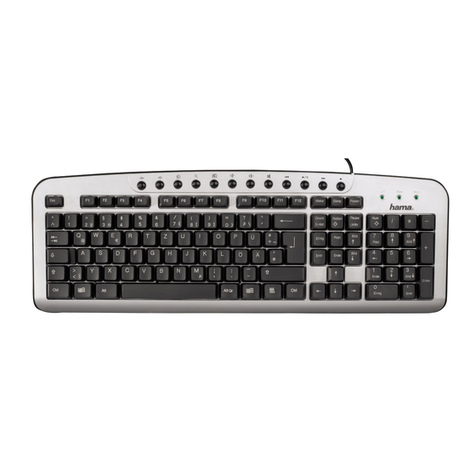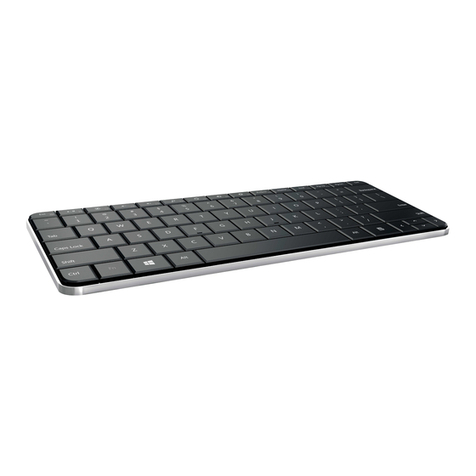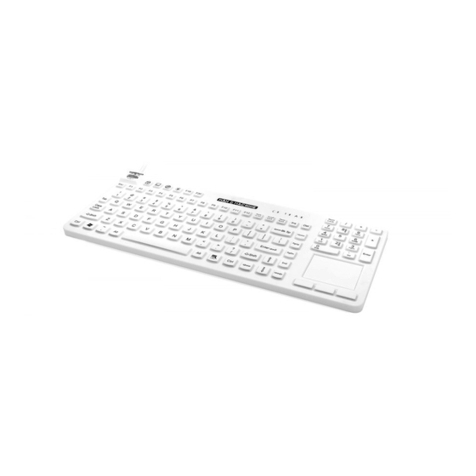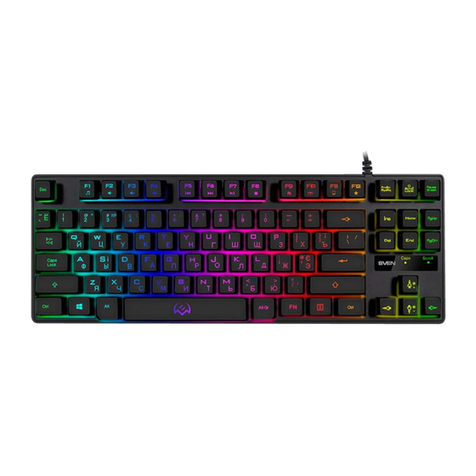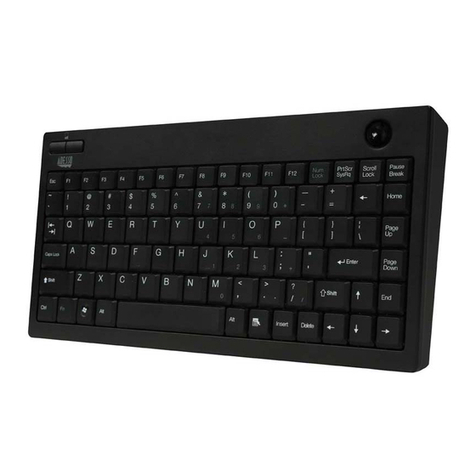Mantis Q40 User manual

User Guide

2
Copyright 2020. All rights reserved, APH.
This User Guide is protected by copyright belonging to
APH, with all rights reserved. The User Guide may not be
copied in whole or in part without written consent from
APH.

3
Contents
Getting Started 7
In the Box 7
Orientation of Mantis Q40 7
Top Face 7
Front Edge 8
Left Edge 8
Rear Edge 8
Bottom Side 9
QWERTY Keyboard Layout 9
Charging Mantis Q40 10
Powering On and Off 10
Adjusting the Sleep Mode 11
About the About Menu 11
Navigating and Using Menus 11
Navigating the Main Menu 11
Panning Text on the Braille Display 12
Using the Context Menu for Additional Functions 12
Navigating by First Letters of Words 13
Using Braille Entry Method to Type 13
Using Shortcuts/Key Combinations to Navigate 14
Using the Editor Application 15
Create a File 15
Open a File 16
Close a File 16
Save a Text File 16
Auto Scrolling Through Written Text in the Editor 16
Modifying Auto Scroll Speed 17

4
Finding Text in a File 17
Finding and Replacing Text 17
Cutting, Copying, and Pasting Text 17
Using the Read Mode 18
Editor Commands Table 19
Using the Library Application 20
Navigating the Book List 20
Searching for Books 21
Accessing Recently Opened Books 21
Managing Your Books 21
Navigating and Accessing Additional Information
in Books 22
Changing the Navigation Level for Books 22
Navigating by Page, Heading, Percentage,
or Bookmarks 23
Auto-Scrolling Through Text in Books in the
Library App 23
Finding Your Current Position in a Book 24
Navigating to the Beginning or End of a Book 24
Searching for Text in a Book 24
Accessing Additional Book Information 24
Adding, Navigating, Highlighting, and Removing
Bookmarks 25
Inserting a Bookmark 25
Navigating to Bookmarks 26
Highlighting Bookmarks 26
Removing Bookmarks 27
Library and Reading Commands Table 27
Using Terminal Mode 29
Connecting and Exiting Terminal Mode 29

5
Determining Mantis Q40 Compatibility 30
Waking Your iOS Device Using the Mantis 30
Using Mantis as an External Keyboard 30
Connecting by USB 30
Connecting by Bluetooth 31
Navigating Between Connected Devices 32
Using the File Manager 32
Browsing Files 33
Selecting a Drive in the File Manager 33
Accessing File and Folder Information 33
Displaying the Current File Path 33
Searching for Files and Folders 34
Sorting Files or Folders 34
Modifying Files and Folders 35
Creating a New Folder 35
Renaming Files or Folders 35
Selecting Files or Folders for Applying Additional
Actions 35
Copying, Cutting, and Pasting Files or Folders 36
Deleting Files or Folders 36
File Manager Commands Table 37
Using the Calculator Application 38
Operating the Calculator 38
Calculator Commands Table 38
Using the Date and Time Application 39
Displaying the Time and Date 39
Setting the Time and Date 40
Setting User Preferences 40
Setting Options Table 41

6
Adding, Configuring, and Deleting Braille Profiles 42
Adding a Braille Profile 42
Configuring or Deleting a Braille Profile 43
Using a Wi-Fi Network or Bluetooth 43
Connecting to a Wi-Fi Network 43
Wi-Fi Settings Table 44
Choosing Bluetooth Mode Options 44
Accessing and Using Online Services 45
Activating Bookshare and Downloading Books 45
Configuring, Managing, and Syncing a NFB Newsline
Account 46
Updating the Mantis Q40 46
Customer Support 47
End User License Agreement 48
Warranty 48

7
Getting Started
Welcome to your new Mantis Q40 keyboard. This keyboard is
both a standard QWERTY keyboard and a refreshable braille
display in one device.
This user guide provides instructions for orientation, usage,
navigation, and updating of the device. For more information
please refer to the Mantis Q40 product page on the APH
website or call APH Customer Service at 1(800) 223-1839.
In the Box
The box contains the following items:
• Mantis Q40 keyboard
• Protective case (TPU)
• Print and Braille Getting Started Guides
• USB power adapter
• USB-A to USB-C recharge cable
Orientation of Mantis Q40
The Mantis has a 40-cell Braille display, a standard QWERTY
keyboard, a Home button, and four Thumb keys for
navigation. There are buttons and ports on the front, back,
and left edges.
Top Face
The top face of the Mantis can be divided into two sections:
front and rear.
The front section consists of a refreshable braille display
containing 40 braille cells and 40 cursor routing buttons. Each
cursor routing button is associated with the cell directly below
it.

8
When editing text, pressing one of the cursor routing buttons
moves the editing cursor to the associated braille cell. For
any other instance, pressing any cursor button activates a
selected item.
The rear section includes a standard computer QWERTY
keyboard.
Front Edge
On the front edge of the Mantis are five buttons. From left to
right, the buttons are as follows:
• Previous thumb key
• Left thumb key
• Home button (circular shape) – used to return to the Main
menu or exit Terminal mode
• Right thumb key
• Next thumb key
Left Edge
On the left edge, from front to back are the following:
• USB-A port
• Power button – press and hold this button for 2 seconds
to turn the device ON
• Green LED – visually indicates the status of the device
• USB-C port – use the cable that came with your Mantis to
connect the Mantis to a power outlet or a PC
Rear Edge
The rear edge only contains an SD card port located near the
left edge of the device. This port allows you to insert SD cards
for external storage.

9
Bottom Side
In each corner underneath your Mantis are four anti-slip pads.
In the middle, closer to the front edge is a slightly indented
rectangle with a different texture. In this rectangle is a sticker
containing printed hardware information about your Mantis.
Above the sticker, there is a braille label containing the serial
number of your device.
Towards the back left of the device is the battery
compartment. It is closed and secured with two Phillips
screws.
QWERTY Keyboard Layout
Starting with the top row (furthest away from you), from
left to right, the keys on the Mantis keyboard are laid out as
follows:
Row 1 (top row): Escape, F1 to F12, Delete
Row 2: Grave accent (`), numbers 1 through 9, zero
(0), hyphen (-), equals (=), Backspace
Row 3: Tab, q, w, e, r, t, y, u, I, o, p, [ (left bracket), ]
(right bracket), \ (backward slash)
Row 4: Caps lock, a, s, d, f, g, h, j, k, l, ; (semicolon), ‘
(apostrophe), Enter
Row 5: Left Shift, z, x, c, v, b, n, m, , (comma), .
(period), / (forward slash), right Shift
Row 6: Left Ctrl (control), Fn (function), Windows, left
Alt (alternate), Spacebar, right Alt, right Ctrl, and Left,
Up, Down, Right Arrows

10
Charging Mantis Q40
Prior to using your Mantis, make sure it is charged completely.
Connect the USB-C end of the recharge cable to the USB-C
port located on the left edge of your Mantis. Minimal effort is
required and forcing the connection can damage the cable or
the device.
Connect the USB-A end of the recharge cable to the power
adapter, then plug the power adapter into a power outlet. Use
the provided power adapter for optimal recharge.
Alternatively, you can charge the device using your computer
and the USB-A to USB-C recharge cable, but note that this
method of charging is slower than charging with a power
adapter.
Powering On and Off
The Power button is on the left edge of the Mantis. It is oval-
shaped with a raised dot in the center.
If your device is charged, press and hold the Power button
for approximately 2 seconds to power On the Mantis. There is
a quick vibration and Starting appears on the braille display
along with a tactile loading animation that circles during start-
up.
After a few seconds, the start-up is complete and “editor”
appears on the braille display. Your Mantis is now ready for
use.
To power Off, press and hold the Power button for
approximately 2 seconds. A confirmation message appears on
the braille display. Select Ok by pressing the Previous or Next
thumb key, then press Enter or a Cursor-routing key.
Alternatively, you can follow these steps to power Off the

11
Mantis:
1. Press P to reach the Power Off menu item.
2. Press Enter or a cursor routing key.
3. Select Ok by pressing the Previous or Next thumb key.
4. Press Enter or a cursor routing key.
Adjusting the Sleep Mode
To preserve the battery, Mantis goes into Sleep mode after 5
minutes of inactivity. You can adjust the length of time in the
settings. You can also manually put your device into Sleep
mode by a short press of the power button.
To wake up the device, press the Power button.
About the About Menu
The About menu provides various information about your
device, such as version numbers, model number, serial
number, licenses, and copyright.
Navigating and Using Menus
Navigating the Main Menu
The Main menu options are:
• Editor
• Terminal
• Library
• File manager
• Calculator
• Date and time
• Settings

12
• Online services
• User guide
• Power Off
Press the Previous or Next thumb keys to scroll through the
list to the menu item of your choice. Then press Enter or a
cursor routing key to access it.
You can return to the Main menu at any time by simply
pressing the Windows key, the Home button, or Ctrl + Alt + H
on the QWERTY keyboard.
Panning Text on the Braille Display
Often times the text on the braille display is too long to fit on
a single line. To read the entire sentence, scroll or “pan” the
text ahead or back by pressing the Left and Right thumb keys
on the Mantis. The Left and Right thumb keys are the second
and fourth buttons on the front edge of the device.
Using the Context Menu for Additional
Functions
The Context menu is a special menu that is accessed from
almost everywhere in the device. It offers useful contextual
functions that are relevant to what you’re currently doing
on your Mantis. Think of it as the Contextual menu of a PC
(the menu you get when you right-click the mouse). If you’re
looking for a specific action, or simply forgot the shortcut,
chances are it can be found in the Context menu.
To activate the Context Menu, press Ctrl + M. A menu opens
with a list of actions you can perform at that particular
moment. Scroll through the menu to the desired action and
press Enter or a cursor routing key.
Press Escape to exit the Context Menu.

13
Navigating by First Letters of Words
Most of the time, you can jump to an item in a menu by
typing the first letter of that item. Doing so automatically
moves your focus to the first item in the list starting with that
letter. Typing the same letter twice moves the focus to the
second item in the list starting with that letter, and so on.
For example, to reach the Settings menu on the Mantis, you
type the letter ‘S’ on your keyboard.
Using Braille Entry Method to Type
Although the Mantis comes with a QWERTY keyboard, it is still
possible to toggle to a Perkins-style keyboard, which uses the
A, S, D, F, J, K, L, and ; keys. With this entry scheme, each
of these keys represents a dot in the braille cell of computer
braille, which has eight cells, as shown in Table 1.
Table 1: Keyboard to Braille Cell Dot Equivalents
QWERTY Key Braille Cell Dot
F 1
D 2
S 3
J 4
K 5
L 6
A 7
; 8
Press F12 to toggle between QWERTY and braille entry. A
prompt is given indicating what input method is in use.

14
Using Shortcuts/Key Combinations to
Navigate
As the name implies, shortcuts, also known as key
combinations, make it easy to quickly navigate through a
menu or file.
The most commonly used shortcuts on the Mantis Q40 are
indicated in Table 2.
Table 2: Shortcut/Key Combination Table
Action Shortcut or Key
Combination
Activate Selected item Enter or cursor routing key
Escape or Back Escape key
Previous item Up Arrow or Previous thumb
key
Next item Down Arrow or Next thumb key
Jump to any item in a list Type the first letter of the item
or app
Pan left and right Left or Right thumb key
Go to top Ctrl + Fn + Left arrow
Go to bottom Ctrl + Fn + Right arrow
Toggle Braille grade Ctrl + Alt + G
Switch Braille profile Ctrl + Alt + L
Battery level Ctrl + Alt + P
Context menu Ctrl + M
Main menu Windows key, Home button, or
Ctrl + Alt + H
System information Ctrl + I
Toggle braille and QWERTY
keyboard
F12

15
Action Shortcut or Key
Combination
Time Ctrl + Alt + T
Date Ctrl + Alt + D
Eject media Ctrl + Alt + E
Using the Editor Application
The Editor is an application that allows you to open, edit,
and create text files on the Mantis. You can open .docx, .doc,
.txt, .brf, and .brl files with the Editor. The files you create or
modify are saved as a .txt file.
To open the Editor, press the Next thumb key until you reach
Editor or press ‘e’ in the Main menu, then press Enter or a
cursor routing key.
The Editor opens in the Editor menu, which includes Create
file, Open file, Editor settings, and Close.
Create a File
There are several ways to create a file depending on your
current location on the device.
• If you are in the Editor menu, select Create file and press
Enter or a cursor routing key.
• From the Context menu, select and activate File menu,
then Create file.
• From any other location on the device, press Ctrl + Alt +
N in the Editor app.
The cursor is visible between two braille brackets. You can
begin writing in your new file.

16
Open a File
If you are in the Editor menu, select Open file and press Enter
or a cursor routing key. From any other location, press Ctrl
+ O, then select the file you wish to open using the Previous
and Next thumb keys.
Close a File
To close a file that is opened in Editor, press the Escape key.
Alternatively, open the Context menu using Ctrl + M, then
scroll to and activate the File menu. Select Close file item.
If there are changes to your file that have not been saved,
you are asked if you want to save the changes before closing.
Save a Text File
There are two types of saving in Editor: Save and Save as.
Save: Press CTRL + S to save your file to an already existing
filename.
Save as: Press Ctrl + Shift + S to save a copy of your file with
a new filename and change the location.
If your file has never been saved, Editor asks you to enter a
new filename regardless of the save method you choose.
Auto Scrolling Through Written Text in the
Editor
The Editor app features an Auto Scroll functionality that
automatically pans through the written text on the braille
display.
To start Auto Scrolling, press Alt + G.
To stop Auto Scrolling, press any key.

17
Modifying Auto Scroll Speed
You can change the Auto Scroll speed when auto-scrolling
inside a file.
To slow down Auto Scroll, press Ctrl + Alt + -.
To speed up Auto Scroll, press Ctrl + Alt + =.
Finding Text in a File
To find text in your file, press Ctrl + F. Enter your search term
in the blank field. Your cursor is placed at the first location the
text is found.
Press F3 to find additional instances of the search word.
Press Ctrl + F3 to find the last instance of the search word in
the file.
Finding and Replacing Text
To find and replace text:
1. Press Ctrl + H.
2. Enter the text to find in the first edit box.
3. Enter the text to replace it with in the second prompted
edit box.
4. Press the Next button to find the next instance of the
word.
5. Press the Down Arrow or the Next button to find Replace
All.
Cutting, Copying, and Pasting Text
The Editor lets you cut, copy, and paste text in a way similar
to computer programs.

18
To Select the text, position your cursor on the first character
using a cursor routing button, then press F8.
Alternatively, you can select text from the Context menu:
1. Open the Context menu with Ctrl + M.
2. Scroll down to Edit.
3. Press Enter or a cursor routing key.
4. Scroll down to Select Text.
5. Press Enter or a cursor routing key.
This marks the start of your selection. Now go to the location
of the end of your selection, and press Enter or a cursor
routing key to end the selection.
To Select All text included in the file, press Ctrl + A.
To Copy the selected text, press Ctrl + C.
To Cut the selected text, press Ctrl + X.
To Paste the copied or cut text, position your cursor where
you want the text to be pasted using a cursor routing button
and press Ctrl + V.
As always, these commands can be accessed through the
Context menu.
Using the Read Mode
Read mode allows you to read files without the possibility of
editing content by mistake. You cannot edit files while in Read
mode.
To activate or deactivate Read mode, press Ctrl + R.
To activate or deactivate Read mode from the Context menu:
1. Press Ctrl + M to activate the Context menu.
2. Scroll to File using the Previous and Next thumb keys.

19
3. Scroll to Read mode using the Previous and Next thumb
keys.
4. Press Enter or a cursor routing key.
Editor Commands Table
The Editor commands are listed in Table 3.
Table 3: Editor Commands
Action Shortcut or Key
Combination
Activate edit mode Enter or a cursor routing key
Leave edit mode Escape
Create file Ctrl + Alt + N
Open file Ctrl + O
Save Ctrl + S
Save as Ctrl + Shift + S
Find Ctrl + F
Find next F3
Find previous Shift + F3
Replace Ctrl + H
Start/Stop selection F8
Select all Ctrl + A
Copy Ctrl + C
Cut Ctrl + X
Paste Ctrl + V
Delete previous word Ctrl + Backspace
Delete current word Ctrl + Delete
Delete previous character Backspace
Move to next edit box while
editing
Home button

20
Action Shortcut or Key
Combination
Move to next edit box
without editing
Tab, Next thumb key, or Alt +
Right Arrow
Move to previous edit box
without editing
Shift + Tab, Previous thumb
key, or Alt + Left Arrow
Move insertion point to start
of text field document
Ctrl + Home
Move insertion point to end
of text field document
Ctrl + End
Start auto-scroll Alt + G
Increase auto-scroll speed Ctrl + Alt + =
Decrease auto-scroll speed Ctrl + Alt + -
Toggle Reading mode Ctrl + R
Using the Library Application
The Library is the application you use to read books on the
Mantis. It supports the file formats .brf, .pef, .txt, .html,
.docx, and .rtf, and is compatible with .zip files containing
books in text format.
To open the Library app, press the Next thumb key until you
reach Library, or press l in the Main menu. Press Enter or a
cursor routing key to access the app.
The Library menu includes Book list, Recently read, Search,
and Close.
Navigating the Book List
In Library, your books are stored in a Book list, comparable to
a directory containing all the available media on your device
in alphabetical order.
Table of contents
Popular Keyboard manuals by other brands
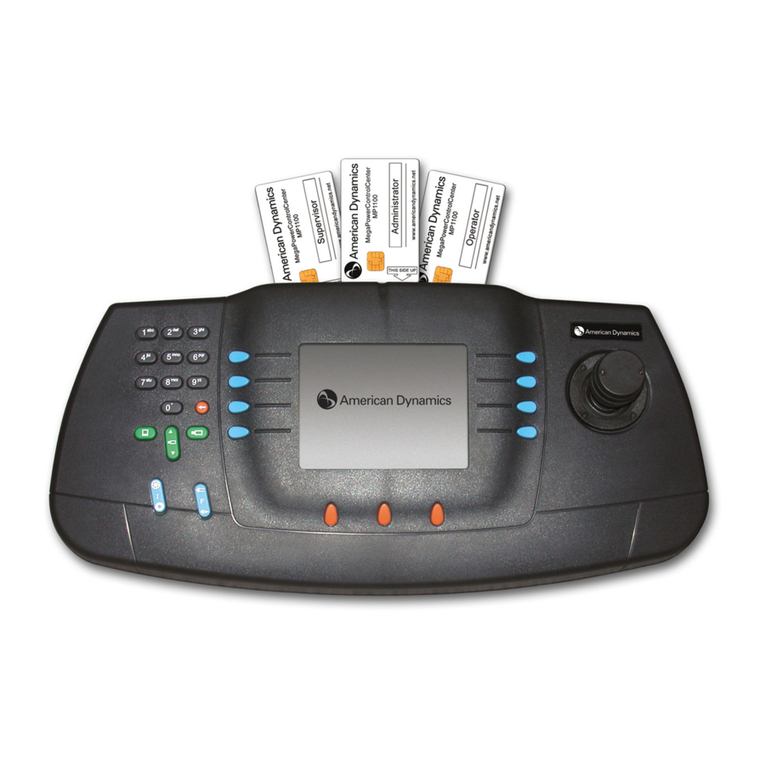
American Dynamics
American Dynamics ControlCenter ADCC1100 Installation and operation instructions

thomann
thomann ControlKey 61 user manual
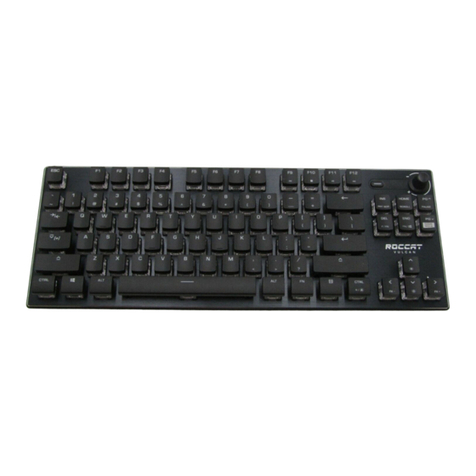
Roccat
Roccat VULCAN TKL PRO Quick installation guide
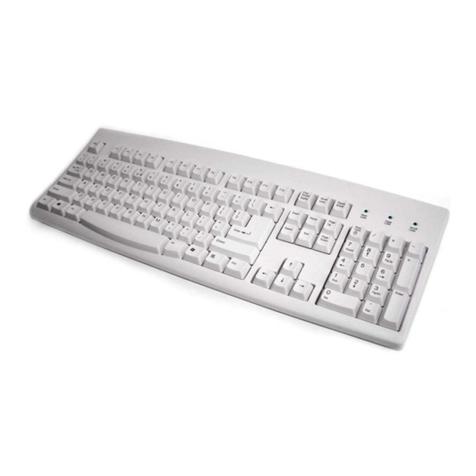
Ceratech
Ceratech Accuratus KYBAC260-PS2USHY Specifications
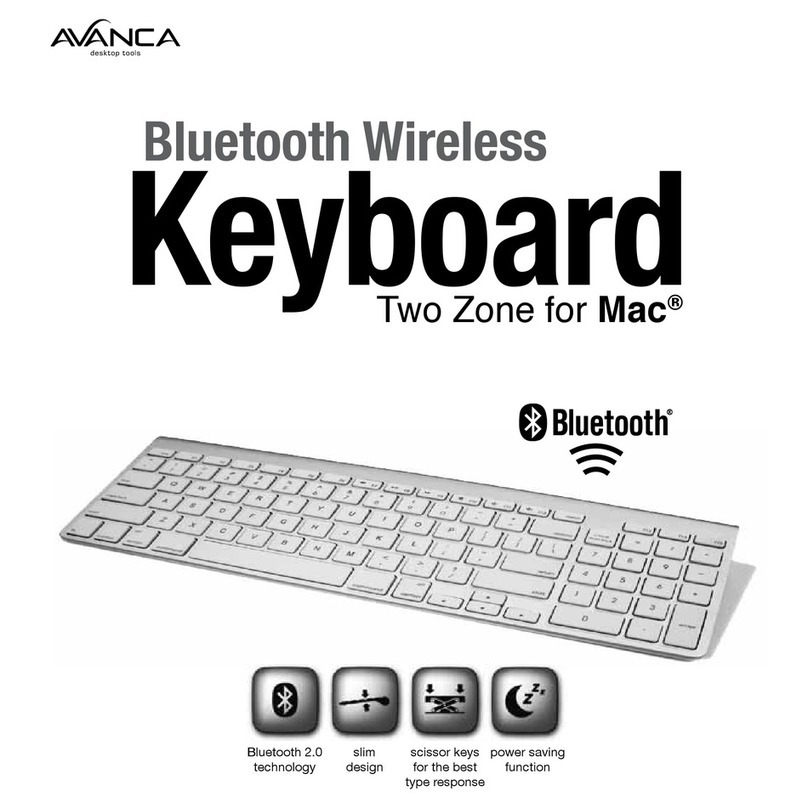
Avanca
Avanca Bluetooth Wireless Keyboard user guide
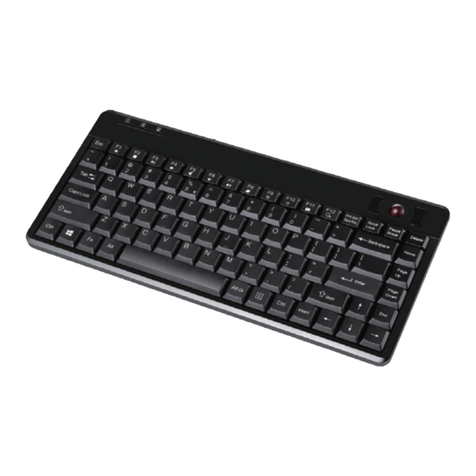
perixx
perixx PERIBOARD-706 PLUS user manual

